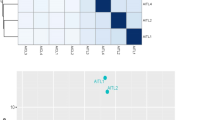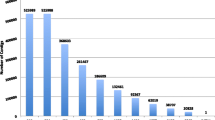Abstract
The aims of this study were to sequence the transcriptome and organize the sequence data into a searchable database for the brain coral Platygyra carnosus, a structure-forming dominant species along the coast of southern China. We collected healthy and tumorous coral tissues from two locations, extracted RNA from each tissue sample, pooled the RNA from all tissue samples, generated a cDNA library from the pooled samples, and conducted paired-end sequencing of the cDNA library using the Illumina platform to produce 59.6 M clean sequences with a read length of 90 bp. De novo assembly of the sequence data resulted in 162,468 unigenes with an average length of 606 bp (range, 201 to 23,923 bp). This is the largest transcriptome dataset for a species of coral whose genome has not been sequenced. A BLASTx search against the NCBI protein database showed that 55,355 of the unigenes matched at least a sequence with an E-value of < 0.00001; 59 % of the matched sequences are from Metazoa, 13 % are from Alveolata to which the symbiont Symbiodinium belongs, and 7 % are from bacteria. A database (PcarnBase) was constructed to provide easy access to the unigenes with attributes such as NCBI protein annotation, GO annotation, and KEGG pathway. It will facilitate functional genomic studies of P. carnosus, such as biomarker discovery for bleaching, tumor formation, and disease development at the gene or protein level, involvement of coral symbiotic algae in the host coral’s stress responses, and genetic basis of stress resistance.





Similar content being viewed by others
References
Bay LK, Ulstrup KE, Nielsen HB, Jarmer H, Goffard N, Willis BL, Miller DJ, Van Oppen MJ (2009) Microarray analysis reveals transcriptional plasticity in the reef building coral Acropora millepora. Mol Ecol 18:3062–3075
Bhagooli R, Hidaka M (2004) Photoinhibition, bleaching susceptibility and mortality in two scleractinian corals, Platygyra ryukyuensis and Stylophora pistillata, in response to thermal and light stresses. Comp Biochem Physiol A Mol Integr Physiol 137:547–555
Bryant D, Burke L, McManus J, Spalding M (1998) Reefs at risk. A map-based indicator of threats to the world’s coral reefs. World Resources Institute, Washington
Burke L, Selig E, Spalding M (2002) Reefs at risk in Southeast Asia. World Resources Institute, Washington
Chen TY, Yu KF, Shi Q, Li S, Wang R, Zhao MX (2007) Distribution and status of scleractinian coral communities in Daya Bay, Guangdong. Trop Geogr 27:493–498
Chiu JM, Li S, Li A, Po B, Zhang R, Shin PK, Qiu JW (2012) Bacteria associated with skeletal tissue growth anomalies in the coral Platygyra carnosus. FEMS Microbiol Ecol 79:380–391
Coles SL (1994) Extensive disease outbreak at Fahl Island, Gulf of Oman, Indian Ocean. Coral Reefs 13:242
Conesa A, Götz S, García-Gómez JM, Terol J, Talón M, Robles M (2005) Blast2GO: a universal tool for annotation, visualization and analysis in functional genomics research. Bioinformatics 21:3674–3676
BCL (Binnie Consultants Limited) (1995) 1994 Hypoxia and mass mortality event in Mirs Bay. Final report to the Geotechnical Engineering Office, Civil Engineering Department, Hong Kong Government
Deng W, Nickle DC, Learn GH, Maust B, Mullins JI (2007) ViroBLAST: a stand-alone BLAST web server for flexible queries of multiple databases and user's datasets. Bioinformatics 23:2334–2336
DeSalvo MK, Sunagawa S, Fisher PL, Voolstra CR, Iglesias-Prieto R, Medina M (2010) Coral host transcriptomic states are correlated with Symbiodinium genotypes. Mol Ecol 19:1174–1186
Edge SE, Morgan MB, Gleason DF, Snell TW (2005) Development of a coral cDNA array to examine gene expression profiles in Montastraea faveolata exposed to environmental stress. Mar Pollut Bull 51:507–523
Forêt S, Kassahn KS, Grasso LC, Hayward DC, Iguchi A, Ball EE, Miller DJ (2007) Genomic and microarray approaches to coral reef conservation biology. Coral Reefs 26:475–486
Grabherr MG, Haas BJ, Yassour M, Levin JZ, Thompson DA, Amit I, Adiconis X, Fan L, Raychowdhury R, Zeng Q, Chen Z, Mauceli E, Hacohen N, Gnirke A, Rhind N, di Palma F, Birren BW, Nusbaum C, Lindblad-Toh K, Friedman N, Regev A (2011) Full-length transcriptome assembly from RNA-Seq data without a reference genome. Nat Biotechnol 29:644–652
Grasso LC, Maindonald J, Rudd S, Hayward DC, Saint R, Miller DJ, Ball EE (2008) Microarray analysis identifies candidate genes for key roles in coral development. BMC Genomics 9:540
Hoegh-Guldberg O, Mumby PJ, Hooten AJ, Steneck RS, Greenfield P, Gomez E, Harvell CD, Sale PF, Edwards AJ, Caldeira K, Knowlton N, Eakin CM, Iglesias-Prieto R, Muthiga N, Bradbury RH, Dubi A, Hatziolos ME (2007) Coral reefs under rapid climate change and ocean acidification. Science 318:1737–1742
Huang DW, Sherman BT, Lempicki RA (2009) Systematic and integrative analysis of large gene lists using DAVID bioinformatics resources. Nat Protoc 4:44–57
Hughes TP, Baird AH, Bellwood DR, Card M, Connolly SR, Folke C, Grosberg R, Hoegh-Guldberg O, Jackson JB, Kleypas J, Lough JM, Marshall P, Nyström M, Palumbi SR, Pandolfi JM, Rosen B, Roughgarden J (2003) Climate change, human impacts, and the resilience of coral reefs. Science 301:929–933
Iseli C, Jongeneel CV, Bucher P (1999) ESTScan: a program for detecting, evaluating, and reconstructing potential coding regions in EST sequences. Proc Int Conf Intell Syst Mol Biol 138–148
Lam K, Shin PKS, Hodgson P (2007) Severe bioerosion caused by an outbreak of corallivorous Drupella and Diadema at Hoi Ha Wan Marine Park, Hong Kong. Coral Reefs 26:893
Levy O, Kaniewska P, Alon S, Eisenberg E, Karako-Lampert S, Bay LK, Reef R, Rodriguez-Lanetty M, Miller DJ, Hoegh-Guldberg O (2011) Complex diel cycles of gene expression in coral–algal symbiosis. Science 331:175
Littler MM, Littler DS (1996) Black band disease in the South Pacific. Coral Reefs 15:20
Loya Y, Bull G, Pichon M (1984) Tumor formations in scleractinian corals. Helgoland Mar Res 37:99–112
Mayfield AB, Hsiao YY, Fan TY, Chen CS, Gates RD (2010) Evaluating the temporal stability of stress-activated protein kinase and cytoskeleton gene expression in the Pacific reef corals Pocillopora damicornis and Seriatopora hystrix. J Exp Mar Biol Ecol 395:215–222
Meyer E, Aglyamova GV, Wang S, Buchanan-Carter J, Abrego D, Colbourne JK, Willis BL, Matz MV (2009) Sequencing and de novo analysis of a coral larval transcriptome using 454 GSFlx. BMC Genomics 10:219
Morrissy AS, Morin RD, Delaney A, Zeng T, McDonald H, Jones S, Zhao Y, Hirst M, Marra MA (2009) Next-generation tag sequencing for cancer gene expression profiling. Genome Res 19:1825–1835
Nybakken JW, Bertness MD (2005) Marine biology: an ecological approach, 6th edn. Benjamin Cummings, San Francisco
Pertea G, Huang X, Liang F, Antonescu V, Sultana R, Karamycheva S, Lee Y, White J, Cheung F, Parvizi B, Tsai J, Quackenbush J (2003) TIGR Gene Indices Clustering Tools (TGICL): a software system for fast clustering of large EST datasets. Bioinformatics 19:651–652
Portune KJ, Voolstra CR, Medina M, Szmant AM (2010) Development and heat stress induced transcriptomic changes during embryogenesis of the scleractinian coral Acropora palmata. Mar Genom 3:51–62
Schwarz JA, Brokstein PB, Voolstra CR, Terry AY and others (2008) Coral life history and symbiosis: functional genomic resources for two reef building Caribbean corals, Acropora palmata and Monastraea faveolata. BMC Genomics 9:97
Shi Q, Zhao MX, Zhang QM, Wang HK, Wang LR (2007) Growth variations of scleractinian corals at Luhuitou, Sanya, Hainan Island, and the impacts from human activities. Acta Ecologica Sin 27:3316–3323
Shinzato C, Shoguchi E, Kawashima T, Hamada M, Hisata K, Tanaka M, Fujie M, Fujiwara M, Koyanagi R, Ikuta T, Fujiyama A, Miller DJ, Satoh N (2011) Using the Acropora digitifera genome to understand coral responses to environmental change. Nature 476:320–323
Sutherland KP, Porter JW, Torres C (2004) Disease and immunity in Caribbean and Indo-Pacific zooxanthellate corals. Mar Ecol Prog Ser 266:273–302
Thinesh T, Mathews G, Edward JKP (2011) Coral disease prevalence in the Palk Bay, Southeastern India—with special emphasis to black band. Indian J Mar Sci 40:813–820
Traylor-Knowles N, Granger BR, Lubinski TJ, Parikh JR, Garamszegi S, Xia Y, Marto JA, Kaufman L, Finnerty JR (2011) Production of a reference transcriptome and transcriptomic database (PocilloporaBase) for the cauliflower coral, Pocillopora damicornis. BMC Genomics 12:585
Vargas-Ángel B (2009) Coral health and disease assessment in the U.S. Pacific remote island areas. B Mar Sci 84:211–227
Veron J (2000) Corals of the world. Australian Institute of Marine Science, Townsville
Voolstra CR, Sunagawa S, Matz MV, Bayer T, Aranda M, Buschiazzo E, Desalvo MK, Lindquist E, Szmant AM, Coffroth MA, Medina M (2011) Rapid evolution of coral proteins responsible for interaction with the environment. PLoS ONE 6:e20392
Wang XW, Luan JB, Li JM, Bao YY, Zhang CX, Liu SS (2010) De novo characterization of a whitefly transcriptome and analysis of its gene expression during development. BMC Genomics 11:400
Whitmarsh SJ (2010) A central role for p38 MAPK in the early transcriptional response to stress. BMC Biol 8:47
Wilkinson C (ed) (2004) Status of the coral reefs of the world: 2004. Global Coral Reef Monitoring Network and Australian Institute of Marine Science
Ye J, Fang L, Zheng H, Zhang Y, Chen J, Zhang Z, Wang J, Li S, Li R, Bolund L, Wang J (2006) WEGO: a web tool for plotting GO annotations. Nucleic Acids Res 34:W293–W297
Zhao MX, Yu KF, Zhang QM, Shi Q (2010) Long term change in coral cover in Luhuitou fringing reef, Sanya. Oceanologia Limnologia Sin 41:440–447
Acknowledgments
This paper is the result of a collaboration between Agriculture, Fisheries and Conservation Department, Hong Kong SAR Government, and Department of Biology, Hong Kong Baptist University (HKBU). A grant to JX from HKBU supported the database construction. Transcriptome sequencing was conducted by Beijing Genomics Institute, Shenzhen, China.
Author information
Authors and Affiliations
Corresponding authors
Electronic supplementary material
Below is the link to the electronic supplementary material.
ESM 1
Map showing the location of Hong Kong in the southeastern coast of China and the two collection sites (Hoi Ha Wan, Sharp Island) for P. carnosus in eastern Hong Kong (DOCX 56.1 kb)
ESM 2
A total of 242 KEGG pathways found in the transcriptome of P. carnosus (DOC 266 kb)
ESM 3
A total of 5,656 non-sea anemone genes shared by P. carnosus and Porites digitifera showing the gene names, the best-matched NCBI protein accession numbers, annotations, and species (XLSX 169 kb)
ESM 4
Human p38 MAPK pathway deduced from KEGG. Genes framed in a red box are found in our P. carnosus transcriptome database (DOCX 285 kb)
Rights and permissions
About this article
Cite this article
Sun, J., Chen, Q., Lun, J.C.Y. et al. PcarnBase: Development of a Transcriptomic Database for the Brain Coral Platygyra carnosus . Mar Biotechnol 15, 244–251 (2013). https://doi.org/10.1007/s10126-012-9482-z
Received:
Accepted:
Published:
Issue Date:
DOI: https://doi.org/10.1007/s10126-012-9482-z




